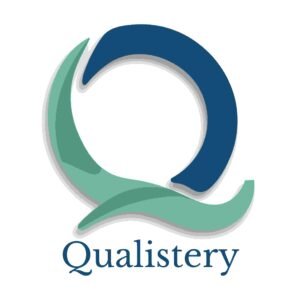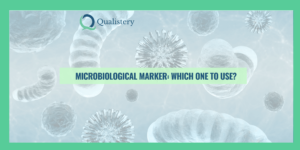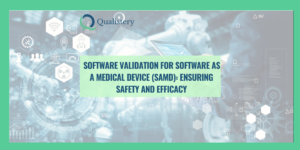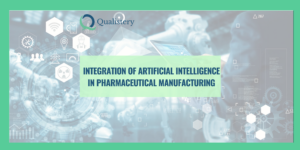Introduction
In the ever-changing landscape of Good Manufacturing Practices (GMP), it is crucial to stay updated on the latest developments to maintain compliance, uphold quality, and ensure safety in pharmaceutical production, and the years 2022 and 2023 marked significant progress in regulatory frameworks technological integration, and industry best practices.
In this article, we will delve into the most critical GMP news and updates from these pivotal years. From the revised ICH guidelines, the integration of Artificial Intelligence in Quality Assurance, and remote batch release, we will explore the transformative shifts that are reshaping the pharmaceutical industry.
By comprehending and adapting to these transformative updates, professionals and stakeholders alike are poised to lead the way in ensuring quality, safety, and innovation in pharmaceutical production. Let’s embark on this trip together.
Revised ICH Q9: Enhancing Risk Management Clarity
The revised version of ICH Q9, known as ICH Q9(R1) and effective from July 2023, introduces significant changes to address critical aspects of Quality Risk Management (QRM).
One of the pivotal shifts is the terminological adjustment from “Risk Identification” to “Hazard Identification.” This adjustment is rooted in the nuanced differentiation between “hazard” and “risk.” While a “hazard” signifies the inherent potential of an element to cause harm, “risk” encompasses the likelihood and severity of that harm occurring, factoring in the exposure to the hazard.
This nuanced shift highlights a more proactive approach, placing emphasis on the identification and analysis of hazards prior to assessing associated risks. This approach fosters a more meticulous and forward-thinking risk management strategy within the pharmaceutical industry.
Furthermore, the revised ICH Q9 (R1) delves into the concept of “formality” within Quality Risk Management. Section 5.1 provides a comprehensive elucidation of what “formality” entails in the context of QRM, enhancing clarity and understanding not fully addressed in the previous version of the guideline. It clarifies that “formality” exists on a spectrum, allowing for varying degrees to be applied during different stages of QRM activities, including risk-based decision-making. This nuanced comprehension allows for a more tailored approach to risk management, affording professionals the flexibility to adapt to specific demands.
Additionally, the guideline outlines a method for determining the appropriate level of formality QRM requires based on three critical factors: Uncertainty, Importance, and Complexity. The greater the uncertainty, importance, and complexity of a quality risk management activity, the more formality and systematic approaches it necessitates.
Point 5.3 of ICH Q9(R1) further addresses the pervasive issue of “subjectivity” within QRM, identifying it as a central concern in the QRM process. It highlights stages where subjectivity is most likely to be introduced, including hazard identification, estimation of the probability of occurrence/severity of harms, and evaluation of the impact of risk reduction strategies. The guideline underscores the critical need to acknowledge individual biases among stakeholders and systematically scrutinize each assumption to mitigate subjectivity’s influence.
Advocating for a structured approach to risk assessment, the guideline emphasizes the awareness of biases, the use of appropriate QRM tools, and reliance on credible sources of knowledge. Encouraging a more profound and critical analysis at each step of the process aims to minimize room for subjective interpretations, fostering a more objective and reliable QRM process. This approach ensures that risk management decisions are firmly grounded in a robust analytical foundation, ultimately promoting safety and efficacy in the pharmaceutical industry.
These revisions within ICH Q9(R1) collectively mark a significant stride toward refining risk management practices within the pharmaceutical industry, ensuring a more robust, transparent, and effective approach to QRM.
Introducing ICH Q13: Revolutionizing Continuous Manufacturing
We are excited to introduce the recently adopted ICH Q13 guideline, which addresses the continuous manufacturing (CM) of drug substances and drug products. Officially adopted in November 2022, this guideline provides crucial scientific and regulatory considerations for the development, implementation, and lifecycle management of CM, building upon existing ICH quality guidelines.
ICH Q13 offers a comprehensive understanding of CM concepts, placing emphasis on the integrated nature of a CM system where two or more unit operations are directly connected. It covers various modes of CM, batch definitions, and the scientific approaches necessary for maintaining a consistent state of control during production, including considerations of process dynamics, material characterization, and control, among other critical factors.
This guideline represents a transformative leap forward in the pharmaceutical landscape, paving the way for a shift from traditional batch manufacturing to a dynamic and continuous manufacturing approach. It highlights the importance of recognizing process dynamics to sustain control in CM, particularly in addressing the impact of transient events on material quality and the formulation of an appropriate control strategy.
Furthermore, it highlights the pivotal role of equipment design and system integration in influencing process performance and the quality of output materials. By deepening the understanding of CM, this guideline sets the stage for a more streamlined, efficient, and adaptable manufacturing process, ushering in a new era of innovation in pharmaceutical production.
Analyzing the Evolution of EU GMP Annex I
The recent update to the EU GMP Annex 1 in 2022, which focuses on sterile manufacturing, marks a substantial expansion from its previous iteration, growing from 16 to 59 pages. This notable increase signifies a more detailed and comprehensive approach to maintaining sterility in pharmaceutical production.
One of the key changes is evident in part 2, titled “Principle,” which now places a strong emphasis on a well-articulated contamination control strategy. Additionally, part 3, “Pharmaceutical Quality System,” meticulously delineates the requisites of an effective Pharmaceutical Quality System applied to sterile manufacturing.
Part 4, “Premises,” has undergone significant expansion, providing detailed qualification requirements for cleanrooms—a pivotal aspect in sterile manufacturing. Furthermore, a new section, part 6, “Utilities,” has been introduced to specifically address the standards governing water and steam that come into contact with the final product. This addition ensures a higher level of safety in pharmaceutical products.
In addition to these updates, the revised Annex 1 places a heightened focus on personnel knowledge and training within the clean room and Quality Control lab. This emphasis is observable in part 7, “Personnel,” and part 10, “Quality Control,” respectively.
Part 8, “Production and specific technologies,” delves into the production of sterile products, reiterating the incorporation of a Contamination Control Strategy to uphold the quality of products. Furthermore, part 9, “Environmental and process monitoring,” stands as the most extensive section, outlining precise methods for monitoring and documenting processes within cleanroom environments. This meticulous approach fosters a more controlled and safe production space.
These substantial changes emphasize a more stringent and detailed approach to sterile manufacturing than ever before. This regulation is geared towards elevating the quality and safety standards by increasing the testing burden and emphasizing the critical importance of a well-defined Contamination Control Strategy, as well as personnel training.
AI in Quality Assurance (QA)
Artificial Intelligence (AI) is progressively revolutionizing every industry, and the pharmaceutical sector won’t be the exception. How could AI enhance a QA team?
AI streamlines the analysis of extensive volumes of manufacturing and quality control data, a task that traditionally demanded substantial human effort and time. Leveraging machine learning algorithms, AI proficiently identifies patterns, detects anomalies, and generates insights to assist the Qualified Person (QP) in their review process, encompassing the assessment of deviations and investigations.
Moreover, AI enables real-time monitoring of critical parameters, empowering manufacturers to make well-informed decisions regarding process adjustments and interventions to support immediate release determinations. Another noteworthy application lies in predictive maintenance, where AI algorithms forecast equipment failures before they occur, minimizing downtime and enhancing overall productivity. This proactive approach, facilitated by AI, ensures not only the longevity and optimal performance of equipment but also fosters a more efficient and dependable manufacturing environment, representing a significant advancement in the pharmaceutical industry’s pursuit of excellence and reliability.
AI also plays a pivotal role in reviewing Quality Risk Management (QRM) activities. It analyzes data from various sources to identify potential hazards and predict their impact on product quality.
As AI continues to evolve, it holds the promise of unlocking even more possibilities, including the autonomous production of reports such as the Product Quality Review (PQR), heralding a future of heightened efficiency and precision in QA processes. However, it is crucial to acknowledge that AI remains a subject of controversy, with its rapid advancements presenting both opportunities and challenges. The industry keenly observes how regulators will adapt to this groundbreaking technology, aiming for a balanced approach that harmonizes innovation with compliance.
Remote QP Batch Confirmation within the EU
In response to the evolving dynamics of the pharmaceutical industry, the European Medicines Agency (EMA) released a set of questions and answers in July 2023 to address the critical issue of remote Qualified Person (QP) batch release (confirmation). This initiative is designed to offer clarity and guidance on the conditions and prerequisites governing the remote certification and confirmation of batches by QPs.
According to this Q&A, the possibility of remote QP batch release is contingent upon approval from the national competent authority overseeing the authorized site. It is the responsibility of manufacturers and QPs to strictly adhere to any specific national requirements that may be stipulated.
When permitted, it is imperative that remote QP certification and confirmation fully align with EU legislation and guidelines. This process must occur within the EU/EEA or Northern Ireland, and this fact must be verifiable through technical means. Furthermore, QPs are still mandated to maintain an up-to-date knowledge base encompassing the products, manufacturing processes, and the pharmaceutical quality system. This ensures a well-founded reliance on the relevant pharmaceutical quality system, necessitating a commitment to understanding the products and manufacturing processes they oversee, even necessitating physical presence on-site when required.
EMA also stated that the implementation of remote QP batch release also demands a structured approach that must be described and controlled within the pharmaceutical quality system. The technical agreement between the Marketing and Importation Authorisation (MIA) holder and the QP should explicitly outline the provisions for remote certification and confirmation, including the specific circumstances that would necessitate the QP’s physical presence on-site.
It is also crucial that QPs have access to all necessary information and data to make informed decisions regarding batch certification and confirmation, in line with the directives of Annex 16. The MIA holder is tasked with facilitating the remote functions of QPs, which includes providing the necessary equipment and support for electronic batch certification, as well as ensuring compliance with EU GMP Annex 11 requirements for IT systems utilized in the process.
Compliance with these stipulations should be verified, for example, through self-inspection programs at the authorized batch release site, maintaining a stringent adherence to the guidelines to ensure the integrity of the batch release process.
Final words
We hope this comprehensive overview of recent advancements and regulatory updates in the pharmaceutical industry has provided you with valuable insights into the evolving landscape of quality management and manufacturing practices. The revisions to ICH Q9, the introduction of ICH Q13, the updated EU GMP Annex I, the integration of AI in QA processes, and the possibility of remote batch release are all crucial steps towards innovation in pharmaceutical production.
We trust that this comprehensive overview of recent advancements and regulatory updates in the pharmaceutical industry has offered you valuable insights into the evolving landscape of quality management and manufacturing practices. The revisions to ICH Q9, the introduction of ICH Q13, the updated EU GMP Annex I, the integration of AI in QA processes, and the potential for remote batch release all represent where the industry is heading.
As the industry continues to embrace these changes, it becomes imperative for professionals and stakeholders to stay abreast of these developments. Exploring further into each of these topics can offer a deeper understanding and help you navigate these transformations effectively. We encourage you to delve into our additional content for in-depth analyses, case studies, and expert perspectives that can aid you in implementing these practices in your own pharmaceutical endeavors.
By staying informed and adopting best practices, we collectively contribute to a more robust, reliable, and forward-thinking pharmaceutical industry. We look forward to accompanying you on this journey of progress and excellence!
But that’s not all! Join our upcoming webinar on October 17th to dive deeper into the latest updates and best practices in global GMP compliance requirements.
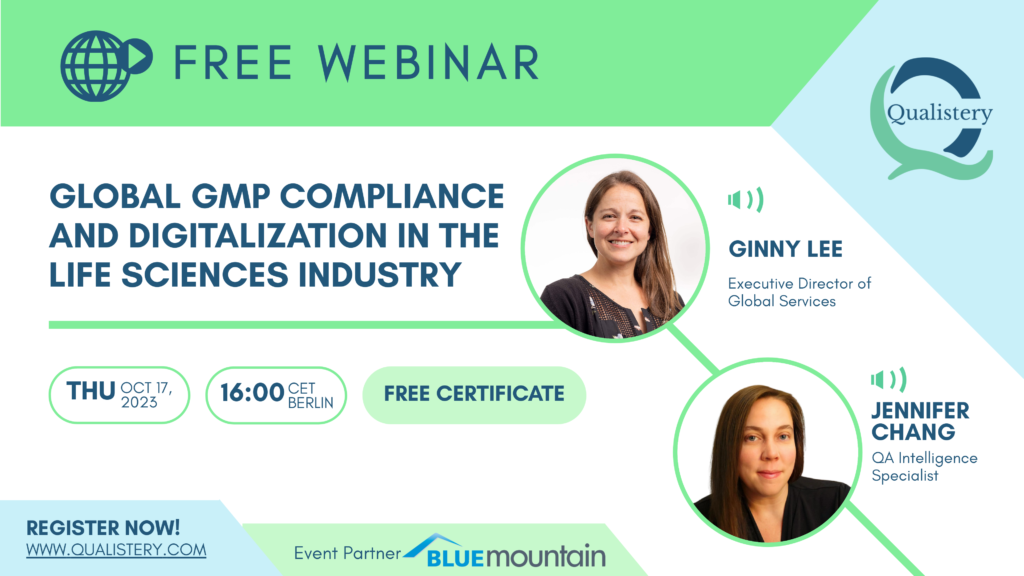
With a dedication to serving the pharmaceutical industry, Qualistery specializes in hosting educational webinars that support both professionals within the pharma sector and service providers. Our commitment lies in empowering businesses to maximize their impact through engaging virtual events and strategic webinar solutions.




